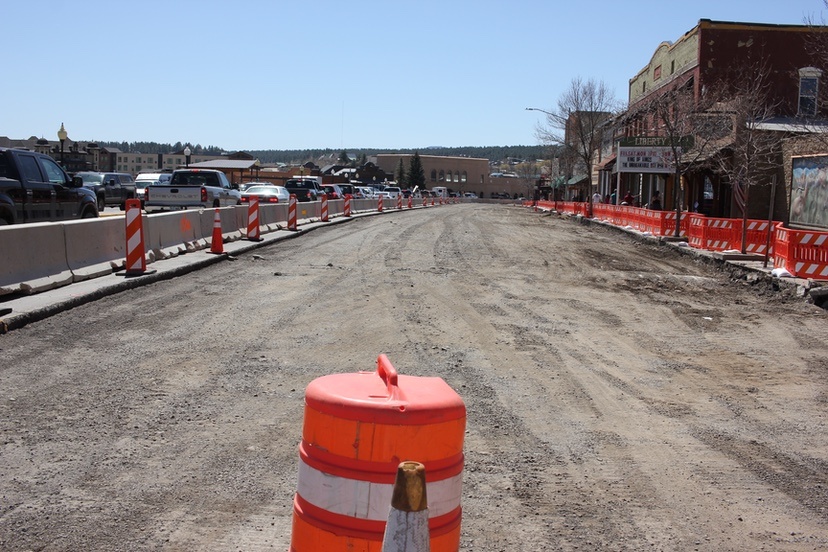I knew I was going to write Part Seven for Monday, so I swung through downtown on Friday, April 11, to get a photo of the WW Clyde crew working hard on the downtown highway reconstruction. Unfortunately, I couldn’t find anyone at work.
I tried again later that day. Still no one. I guess Friday was a holiday?
Also on Friday, in Part Six, I shared the total cost of the repairs and upgrades to be accomplished on behalf of the the Town of Pagosa Springs, to be performed by the contractor — Utah-based WW Clyde — during the reconstruction. The Colorado Department of Transportation (CDOT) has tacked a 26% “management fee” onto some of the work.
As presented by Town Community Development Director James Dickhoff on April 1, the work totals $7.7 million.
As far as I know — and based on the April 1 Council meeting discussion — this amount was not included in the Town budget for 2025, and it isn’t immediately clear where the money will come from. Town Clerk April Hessman told the Town Council that they had maybe $2 million in the Capital Fund reserves, and maybe $2.8 million in the General Fund reserves. But of course, no government wants to totally empty their savings accounts. That’s playing with fire.
The normal preference, for governments, is to go deeper into debt.
For example, the Pagosa Area Water and Sanitation District (PAWSD) recently created about $50 million in new debts, for a new drinking water treatment plant and for upgrades to its wastewater treatment plant. That’s on top of the $10 million still owed on the Running Iron Ranch, purchased in 2008. (PAWSD hopes to sell that ranch in the near future.)
The Town Council seemed somewhat shocked by the $7.7 million quote for the Highway 160 work, and naturally had questions — as we all should have — about how this could be funded.
Town Clerk April Hessman showed a graph, illustrating the amount of Town reserves available to pay for this work — which falls about $3 million short, it appears to me. She suggested that existing Town debts could be rolled over into a new loan that would include the Highway 160 costs, and the Town could likely management such loan payments in the future.
Assuming the local economy continues to grow.
Ms. Hessman:
“So as we looked at this, we could… we could manage this project, if you wanted to go ahead and do the entire $7.7 millions worth of upgrades. We would get a $4 million COP [Certificate of Participation] by my estimate.
“We also have some other options coming before us. So if the Town moves forward with the sales tax increase, you know, we can put a lot of that towards Sanitation. We’d be spending $1.4 million on [Pagosa Springs Sanitation General Improvement District] items. So perhaps we could repay the General Fund for putting that infrastructure in…”
About $1.4 million of the proposed Highway 160 work is sewer pipeline upgrades.
“You know, we’re spending $900,000 on new fire hydrants. Maybe we could work a deal with PAWSD to be reimbursed for that!”
Ms. Hessman laughed as she made that statement, perhaps knowing how unlikely such a reimbursement might be. PAWSD typically requires a developer to pay for new water infrastructure, and in this case, the Town would be the developer.
Town Manager David Harris kept the humor going.
“Other than that, Ms. Lincoln, how was the play?”
Then he referred to the cost of the upcoming infrastructure upgrades as “very sobering”.
“But we heard pretty loud and clear from the Council, that if we’re going to do this, we want to do it right. Let’s not skimp, for lack of a better term.”
Council member Brooks Lindner:
“I’m wondering. Do you guys anticipate any price increases due to the tariff situation?”
His question was met by stony silence.
“I know you might not be able to answer that question. I guess… if the answer is ‘yes’, which it may be, it makes me think there might be some pretty big unknowns, in which case maybe we should just do the priority items…
“That’s just kind of a big thing, to my mind, right now.”
Inflation is a double-edged sword for a government entity like the Town, which relies heavily on sales tax. As consumer prices increase, so does the Town’s sales tax revenue. But if construction materials inflate faster than consumer goods, then the result will be negative.
According to the news on Friday, April 11, China announced it has boosted its tariffs on American-made products to 125%, to match the tariffs on Chinese goods imposed by President Trump. President Trump then announced an increase on China’s tariffs to 145%. Seems our two countries are not getting along very well.
Community Development Director James Dickhoff told the Council he needed an immediate decision, to lock in the pricing and the scheduling.
I find it interesting that the Town has know about this project for three years, and is just now making this last-minute decision. But I do the same kind of thing myself.
The Town Council has been discussing the idea of imposing a new sales tax within the town limits. Town residents would also pay the tax on online purchases. A 1% tax? A 1/2% tax? And the Council has been going back and forth about whether the voters (only the voters living within the town limits) would be more likely to approve a new tax if it were aimed exclusively on the millions of dollars of pending sanitation system repairs.
Council member Leonard Martinez:
“I think we have a better chance [of getting the tax approved] if we keep it focused, and it doesn’t look like anything ‘general’. So my comments were about keeping that intact.”
Council member Lindner:
“I’m totally in agreement with that. I think if we start putting other things [into the ballot measure], it’s doomed.”
Mayor Shari Pierce:
“Yes, I think we need to maintain a real strong focus on [the sanitation system], if we want it to pass…”
She then asked Ms. Hessman if the Town’s reserve accounts could cover the first year of expenditures — considering that the sales tax cannot be approved until November at the earliest.
Town Clerk Hessman:
“That, I don’t know for sure. I’m hoping…”
Standing back a bit, and looking at the big picture — in my imagination — I see the federal government redirecting its support for recreation towards mineral development. I see Colorado’s state government struggling with a $1.5 billion shortfall in next year’s budget. I see tourism tapering off somewhat, nationally, as families tighten their belts to deal with inflation.
But I see our local governments plowing ahead with plans to build new buildings and install new infrastructure.
Like, for example, the Archuleta County government.

